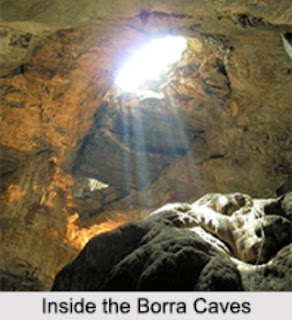Nestled in the Eastern Ghats of India, the Borra
Caves are a stunning example of natural beauty and geological wonder. Located
in the Ananthagiri Hills of Andhra Pradesh, approximately 90 kilometers from
the city of Visakhapatnam, these caves attract tourists, geologists, and
history enthusiasts alike. Renowned for their unique limestone formations and
rich cultural significance, Borra Caves are a remarkable site that offers a
glimpse into the Earth’s ancient past.
The Borra Caves were formed millions of years ago through a combination of geological
processes, including erosion and weathering. The region is primarily composed
of limestone, which is soluble in water, leading to the creation of intricate
cave systems. The caves are situated at an elevation of about 800 meters above
sea level and stretch over an area of approximately 2 kilometers.
The caves exhibit a variety of stunning formations,
including stalactites, stalagmites, and natural pillars. These formations are
often described as resembling various shapes and figures, prompting the
imagination of visitors. The largest chamber of the caves, known as the “Great
Hall,” is particularly impressive, featuring towering ceilings adorned with
delicate limestone structures.
Borra Caves are not just a natural wonder; they
also hold great archaeological importance. Excavations within the caves have
revealed artifacts dating back to the Paleolithic era, indicating that they
were inhabited by prehistoric humans. Tools made of stone and evidence of fire
usage suggest that these caves served as shelters for early hunter-gatherers.
Moreover, the presence of rock art within the caves
adds to their historical significance. Ancient paintings and engravings,
depicting human figures, animals, and geometric patterns, provide insight into
the lives and beliefs of the people who once inhabited these caves. This rock
art serves as a vital link to understanding the cultural practices and artistic
expressions of our ancestors.
The Borra
Caves are steeped in local folklore and mythology. According to popular
belief, the caves are named after the nearby Borra River, which is said to
originate from the depths of the caves. The area is also associated with
various deities and spiritual practices, making it a site of cultural
significance for local communities.
In recent years, the caves have become a popular
destination for tourists, attracting thousands of visitors each year. The government
has developed the surrounding area to facilitate tourism, providing amenities
such as guided tours and pathways to explore the caves safely. Visitors can
experience the breathtaking beauty of the caves while learning about their
historical and cultural context.
Despite their popularity, the Borra Caves face
several conservation challenges. Increasing tourist footfall poses a threat to
the delicate ecosystem within the caves, and measures are necessary to ensure
their preservation.
Educational initiatives aimed at raising awareness
about the ecological and archaeological significance of the Borra Caves are
essential in promoting responsible tourism. By fostering a sense of stewardship
among visitors, we can help preserve the caves for future generations.
The Borra
Caves stand as a testament to the beauty and complexity of nature. With
their striking geological formations and rich archaeological history, these
caves offer a unique opportunity to connect with the past while appreciating
the wonders of the natural world.

No comments:
Post a Comment